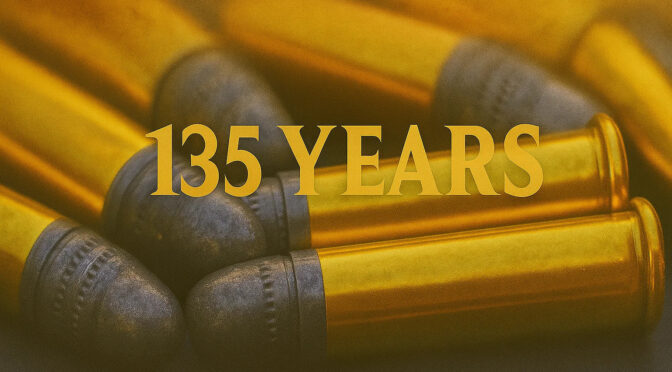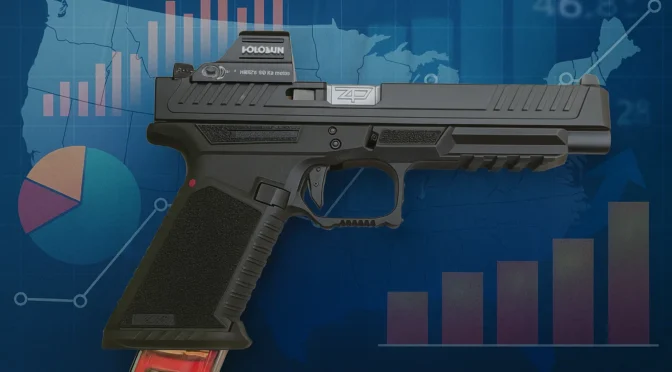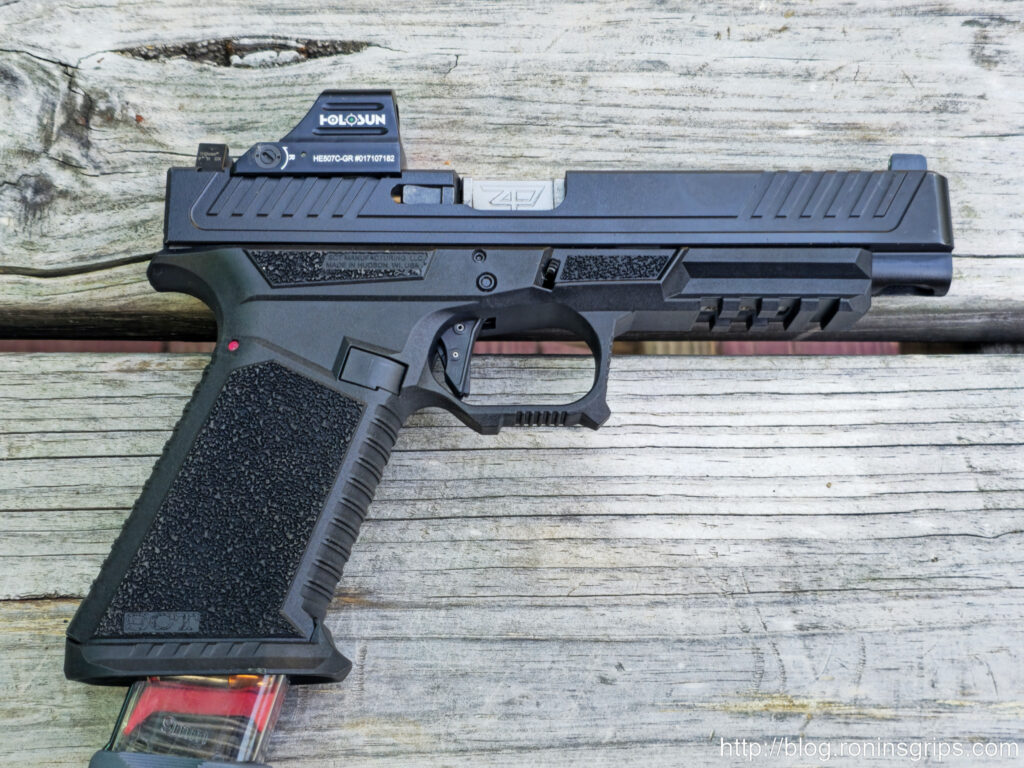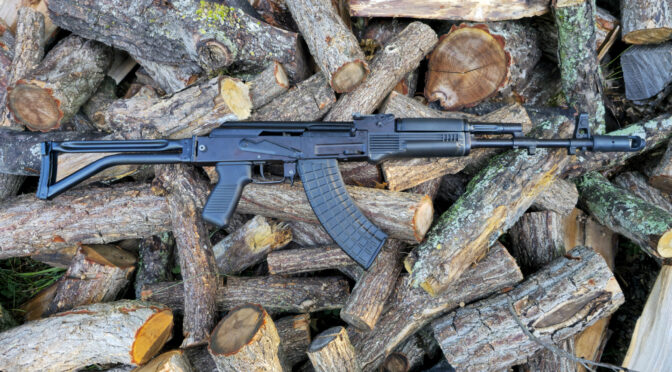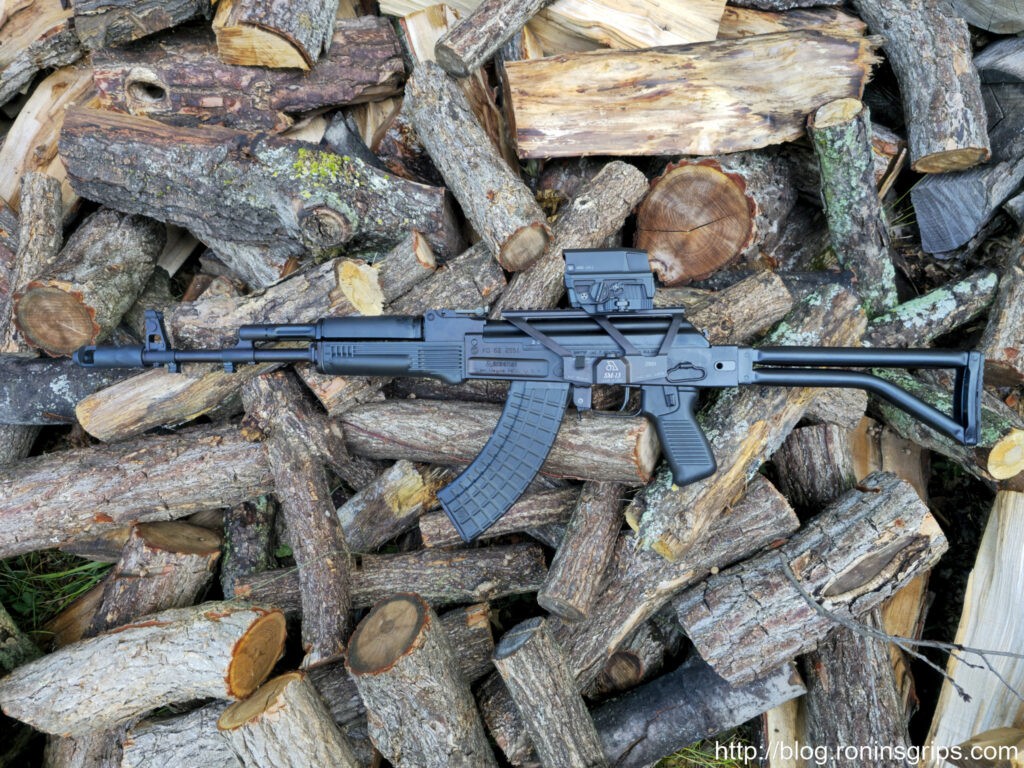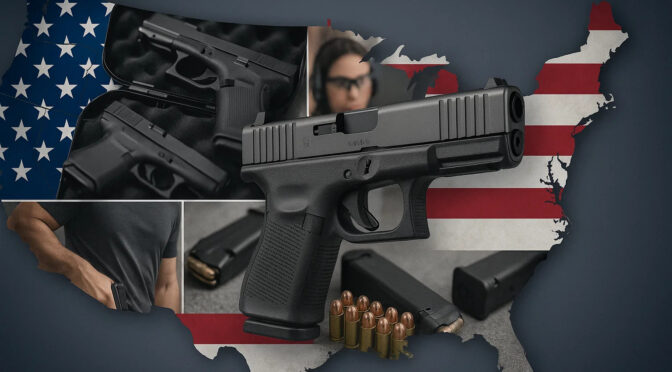The .22 Long Rifle ( .22 LR) cartridge, a titan of the ammunition world, was not a spontaneous invention but the calculated culmination of a 135-year evolutionary process in self-contained metallic ammunition. Its design represents a masterful synthesis of its predecessors’ strengths, a case study in iterative optimization that perfectly met the demands of the late 19th-century market. To understand the .22 LR’s immediate and lasting success, one must first trace the lineage of the small-caliber rimfire cartridges that paved its way.
The Dawn of Self-Contained Cartridges: From Flobert’s Parlor Gun to the American Rimfire Family
The concept of a self-contained cartridge, which packages primer, propellant, and projectile into a single unit, began in Europe. Early designs, such as Jean Samuel Pauly’s 1812 contraption and Benjamin Houllier’s 1835 pinfire cartridge, laid the conceptual groundwork.1 However, the direct ancestor of all modern rimfire ammunition emerged in 1845 from the workshop of Frenchman Louis-Nicolas Flobert.2 Flobert created the 6mm Flobert, or .22 Bulleted Breech (BB) Cap, a diminutive cartridge designed for “parlor shooting”—a popular pastime involving indoor target practice in the homes of the affluent.2 This cartridge was remarkably simple: a percussion cap containing a priming compound was fitted with a small lead ball.3 It contained no separate propellant charge; the detonation of the priming compound alone was sufficient to propel the 18 to 20-grain projectile at low velocities, making it suitable only for its intended indoor use.1
The transformative leap from anemic parlor gun ammunition to a viable field cartridge occurred in the United States. In 1857, the firearms manufacturer Smith & Wesson sought a cartridge for its first firearm, the Model 1 single-action revolver.1 Their solution was to take Flobert’s concept and dramatically improve it. They lengthened the case, added a 4-grain charge of black powder, and topped it with a 29-grain conical bullet.1 The result was the .22 Short, the first American-made metallic cartridge.3 With muzzle velocities exceeding 800 feet per second (fps), the .22 Short possessed enough power for pest control and was even marketed for self-defense in easily concealable pocket pistols.1
The success of the .22 Short established a clear developmental trajectory: the market desired incremental increases in power. This demand led directly to the introduction of the .22 Long in 1871.2 The .22 Long utilized the same 29-grain bullet as the Short but housed it in a longer case, measuring 0.613 inches, which held 5 grains of black powder—a 25% increase over its predecessor.3 This enhancement made it a more effective small-game hunting round.8 The logical next step in this progression was the .22 Extra Long, introduced in 1880. This cartridge featured an even longer case and a heavier, 40-grain bullet propelled by 6 grains of black powder.3 While it delivered superior velocity and energy, it gained a reputation for poor accuracy and never achieved widespread popularity, becoming a “rabbit-trail cartridge” that saw only limited success.1
The Stevens Arms Synthesis: Creating the “Perfect” Rimfire
The market was thus presented with a series of imperfect options. The .22 Short and Long were accurate and reliable but lacked power. The .22 Extra Long offered more power but sacrificed the crucial element of accuracy. The solution, introduced in 1887, came from the J. Stevens Arms & Tool Company of Chicopee, Massachusetts.10 Rather than attempting another linear step in case length or powder charge, Stevens engineers performed a shrewd analysis of the existing cartridges’ components. They recognized that the .22 Extra Long’s 40-grain bullet offered superior ballistic potential but was poorly served by its overly long case, which may have contributed to inconsistent powder ignition. They hypothesized that this superior projectile could be paired with the proven, more efficient case of the .22 Long.1
This combination of the .22 Long’s 0.613-inch case with the .22 Extra Long’s 40-grain bullet created the .22 Long Rifle.1 It was a masterstroke of iterative optimization, a low-risk, high-reward development strategy that perfectly balanced the competing demands of power, accuracy, and cost. The resulting cartridge achieved a higher muzzle velocity and superior performance as both a hunting and target round, rendering the .22 Extra Long almost immediately obsolete.4
Initial Performance and Adoption in the Black Powder Era
The original .22 LR loading, produced by the Union Metallic Cartridge Company, used a black powder charge to propel its 40-grain lead bullet to a muzzle velocity of approximately 1,095 fps from a rifle barrel.1 This level of performance firmly established the new cartridge as the premier rimfire for small-game hunting and target shooting.11
Crucially, J. Stevens Arms & Tool Company was not just an ammunition innovator but also a prolific firearms manufacturer. The company immediately began chambering its popular and affordable line of single-shot “Boys Rifles,” such as the Favorite, Crack Shot, and Marksman models, for the new .22 LR cartridge.10 This synergy between the new cartridge and a readily available, inexpensive platform for its use ensured rapid and widespread adoption by the civilian market. The combination of an effective cartridge and an accessible rifle with a mild report and negligible recoil became the ideal entry point for an entire generation of American shooters, cementing a market position that the .22 LR has held for over 130 years.1
Engineering the .22 Long Rifle: A Technical Analysis
The enduring success and inherent limitations of the .22 Long Rifle cartridge are rooted in two key engineering features inherited from its 19th-century origins: the rimfire ignition system and the heeled bullet design. These legacy characteristics define its performance envelope, dictate its manufacturing process, and are directly responsible for the interlocking compromises that make it both the world’s most affordable cartridge and one with a firm performance ceiling.
The Rimfire Ignition System: Mechanics, Manufacturing, and Inherent Challenges
The defining feature of the .22 LR is its rimfire ignition system. Unlike centerfire cartridges, which utilize a separate, replaceable primer seated in a central pocket in the case head, the .22 LR’s priming compound is integrated directly into the cartridge case.13 The case is formed with a hollow rim, which is then filled with a shock-sensitive priming mixture.17 Ignition is achieved when the firearm’s firing pin strikes and crushes a portion of this rim against the edge of the barrel’s breech face.4 This mechanical crushing action detonates the compound, sending a jet of flame into the main propellant charge.4
The composition of this priming compound is critical. The primary explosive is typically lead styphnate. Because the rimfire system lacks a dedicated internal anvil (as found in Boxer and Berdan primers) to focus the firing pin’s energy, a frictioning agent must be added to the mixture to ensure reliable detonation.18 This agent is typically ground glass, an abrasive material that is not ideal for barrel longevity but is essential for function.18
The manufacturing process for priming a rimfire case is complex and delicate. A small, wet pellet of the priming mixture is dropped into the case. A pin is then inserted, and the entire case is spun at approximately 10,000 rpm.18 This action uses centrifugal force to distribute the wet compound into the hollow rim cavity. This process is the cartridge’s “Achilles’ heel”.18 It is difficult to control with perfect precision, and any uneven distribution or gaps in the priming compound within the rim can lead to two primary failures: a complete misfire (“dud”) if the firing pin strikes a void, or inconsistent ignition, which results in variations in muzzle velocity and a corresponding degradation of accuracy.18 Furthermore, the thin, unsupported brass of the rim forms a weak case head, which limits the Maximum Average Pressure (MAP) the cartridge can safely contain to approximately 24,000 psi.11 This pressure limit is the fundamental barrier that caps the cartridge’s ultimate power potential.
The Heeled Bullet: A Legacy Design and Its Implications for Performance
The second defining feature of the .22 LR is its use of a heeled bullet, a design common in the black powder era but now almost exclusive to this cartridge family.11 In this design, the main bearing surface of the bullet—the portion that engages the barrel’s rifling—is the same diameter as the outside of the cartridge case.20 To allow the projectile to be seated in the case, its base is formed into a narrower-diameter “heel” that fits inside the case mouth.11
This archaic design carries several significant implications for modern performance:
- Outside Lubrication: Because the majority of the bullet’s bearing surface is exposed outside the case, it cannot be lubricated internally like modern non-heeled bullets. Instead, a coating of wax or a similar dry lubricant is applied to the exposed portion of the bullet.21 This external lubricant can easily pick up dirt, dust, and grit from packaging or handling, which can then be introduced into the firearm’s action and bore, potentially causing accelerated wear.21
- Material and Design Limitations: The heeled design makes it practically impossible to apply a thick, structural copper or gilding metal jacket, as is common on centerfire projectiles. .22 LR bullets are therefore typically made of solid lead or lead with a very thin copper plating or wash.23 This plating primarily serves to reduce lead fouling in the barrel and prevent oxidation of the lead, rather than to control terminal expansion.11 This fundamental material limitation restricts the terminal performance of the projectile and presents a significant engineering challenge for the development of effective, non-toxic, lead-free variants.23
- Crimping and Accuracy: To build sufficient initial pressure for consistent ignition, especially given the relatively weak rimfire priming system, the case mouth must be heavily crimped onto the bullet’s heel.18 This crimping process inevitably deforms the soft lead bullet to some degree before it ever leaves the cartridge. This deformation can negatively impact the bullet’s balance and aerodynamic profile, which in turn degrades its potential accuracy.18
The combination of these 19th-century design choices—the rimfire primer and the heeled bullet—creates a system of interlocking compromises. The weak ignition system necessitates a heavy crimp, which deforms the bullet. The heeled bullet design, itself a manufacturing simplification from the revolver era 20, prevents the use of modern jacketed projectiles that could offer better performance. Yet, it is precisely these simplifications that have always made the .22 LR cartridge incredibly cheap to mass-produce, securing its market dominance.
Standardized Cartridge Specifications and Pressure Limits
The physical dimensions and performance limitations of the .22 LR cartridge are standardized by organizations such as the Sporting Arms and Ammunition Manufacturers’ Institute (SAAMI) in the United States and the Commission Internationale Permanente pour l’Epreuve des Armes à Feu Portatives (C.I.P.) in Europe. These specifications provide a baseline for manufacturers of both ammunition and firearms.
Table 1: Technical Specifications of the .22 LR Cartridge
| Parameter | Dimension (Inches) | Dimension (Millimeters) |
| Parent Case | .22 Long | N/A |
| Case Type | Rimmed, Straight | Rimmed, Straight |
| Bullet Diameter | 0 .223 – 0 .2255 | 5.7 – 5.73 |
| Neck Diameter | 0 .226 | 5.7 |
| Base Diameter | 0 .226 | 5.7 |
| Rim Diameter | 0.278 | 7.1 |
| Rim Thickness | 0.043 | 1.1 |
| Case Length | 0.613 | 15.6 |
| Overall Length | 1.000 | 25.4 |
| Rifling Twist | 1:16 | 1:406 |
| Primer Type | Rimfire | Rimfire |
| Max Average Pressure | 24,000 psi | 170 MPa |
Sources: 11
The Evolution of Power and Precision
The maturation of the .22 Long Rifle from its black powder origins into a modern, versatile cartridge is a story of engineers systematically applying advances in chemical and material science to overcome the inherent limitations of its 19th-century design. Each significant leap in performance was a direct solution to a specific problem, pushing the boundaries of what was possible within the cartridge’s fixed physical and pressure constraints.
The Smokeless Revolution: Impact on Velocity, Fouling, and Firearm Design
The original .22 LR cartridges were loaded with black powder, a propellant that had served firearms for centuries but came with significant drawbacks. Black powder is inefficient, with a substantial portion of the charge left behind as a thick, corrosive residue, or fouling.26 This fouling is hygroscopic, meaning it attracts moisture from the air, which can lead to rust and pitting in the firearm’s barrel and action if not cleaned meticulously and promptly after firing.26 In a small-bore firearm like a .22, this buildup could quickly degrade accuracy and impede the function of moving parts.27
The invention of smokeless powder in the late 19th century was a transformative event for all firearms, and the .22 LR was no exception. The transition was gradual; for a time, ammunition manufacturers loaded the cartridge with “semi-smokeless” blends of black powder and nitrocellulose.16 By the 1930s, loads featuring fully smokeless propellants and non-corrosive primers became the industry standard.16
The impact of this transition was profound. Smokeless powder generates significantly more energy and gas pressure from a much smaller volume of propellant compared to black powder.26 This allowed ammunition makers to dramatically increase the .22 LR’s muzzle velocity without altering its external dimensions, boosting its power and flattening its trajectory.1 Perhaps more importantly, smokeless powder burns much more cleanly. The drastic reduction in fouling was the key technological enabler for the development of reliable semi-automatic firearms chambered in .22 LR.6 Actions that rely on the cartridge’s energy to cycle, such as the simple blowback mechanism common in .22 semi-automatics, would quickly become gummed up and unreliable with fouling-prone black powder loads.19 The advent of clean-burning smokeless powder made iconic firearms like the Ruger 10/22 and a host of semi-automatic pistols not just possible, but practical, massively expanding the market for the cartridge.
The Quest for Speed: The Rise of High-Velocity and Hyper-Velocity Loadings
With the adoption of smokeless powder, a new performance standard was established. Ammunition manufacturers developed “High-Velocity” loads that pushed the standard 40-grain lead bullet from its original black powder velocity of around 1,100 fps to speeds in excess of 1,200 fps, with some loads approaching 1,300 fps.1 These offerings became the new benchmark for general-purpose plinking and small-game hunting ammunition.
A second major leap in performance occurred in 1975 with the introduction of the CCI Stinger.16 This was a direct engineering effort to mitigate the .22 LR’s two main ballistic shortcomings: its looping trajectory and its limited terminal energy. To achieve a dramatic increase in velocity while staying within the cartridge’s 24,000 psi pressure limit, CCI’s engineers traded bullet weight for speed. The Stinger featured a lighter 32-grain copper-plated hollow-point bullet.8 To accommodate a larger powder charge, CCI also stretched the case length slightly, though the bullet was seated more deeply to ensure the overall cartridge length remained within the standard specification, allowing it to function in all .22 LR firearms.8
The result was a then-unprecedented muzzle velocity of 1,640 fps, creating a new category of ammunition: “Hyper-Velocity” (defined as 1,400 fps or greater).8 The Stinger’s high velocity flattened the bullet’s trajectory significantly, reducing bullet drop by as much as 3.5 inches at 100 yards compared to standard loads of the day.16 This made hitting small targets at extended ranges much easier and dramatically increased the cartridge’s kinetic energy, making it a far more effective varmint round.16 The Stinger’s success prompted other manufacturers to develop their own hyper-velocity loads, forever changing the landscape of .22 LR performance.
Modern Componentry: Advances in Primers, Propellants, and Projectile Construction
In the modern era, innovation has shifted from raw velocity gains to a focus on consistency and application-specific performance, driven by advances in material science and manufacturing precision.
- Priming and Propellants: For competitive shooting, accuracy is paramount, and accuracy is a direct function of consistency. Top-tier ammunition manufacturers like Lapua, Eley, and RWS use proprietary, highly stable priming compounds and meticulous manufacturing processes to ensure uniform distribution within the rim.7 This, combined with specialized propellants that deliver extremely low standard deviations in muzzle velocity from shot to shot, is what allows match-grade ammunition to produce single-hole groups at 50 yards.2
- Projectile Evolution: The simple lead round nose (LRN) bullet has been joined by a host of advanced projectile designs tailored for specific tasks. Copper plating is now standard on most high-velocity loads to reduce barrel fouling.11 Hollow-point (HP) designs, which feature a cavity in the bullet’s nose, are engineered to expand upon impact with soft tissue, creating a wider wound channel and transferring energy more efficiently for humane small-game harvesting.16 CCI further developed this concept with its Segmenting Hollow Point (SHP), a projectile designed to fracture into three distinct pieces upon impact, creating multiple wound paths to maximize terminal effect on varmints.16 Most recently, innovations like CCI’s “Clean-22” line feature a polymer coating applied to the bullet. This polymer jacket dramatically reduces friction in the barrel and all but eliminates lead fouling, making firearm cleaning simpler and less frequent—a direct material science solution to the persistent problems caused by the cartridge’s unjacketed, externally lubricated heeled bullet design.16
A Modern Taxonomy of .22 LR Ammunition
The immense diversity of modern .22 LR ammunition is a direct reflection of its market maturity and the breadth of its user base. Over more than a century, the firearms chambered for the cartridge have evolved from simple single-shot rifles into a vast ecosystem of specialized platforms, including high-precision competition rifles, suppressed semi-automatics, and lightweight survival guns. In response, ammunition manufacturers have developed highly optimized loads to meet the specific demands of these applications. This has resulted in a landscape where ammunition is best categorized not just by its components, but by its intended performance and purpose.
Analysis by Velocity Class
The muzzle velocity of a .22 LR bullet is a primary determinant of its trajectory, energy, and sound signature. Modern loads can be grouped into four distinct velocity categories.
- Subsonic (<1,100 fps): These loads are engineered to ensure the projectile’s velocity remains below the speed of sound (approximately 1,126 fps at sea level) for its entire flight path.13 This eliminates the sharp “crack” of a sonic boom, resulting in a much quieter report, which is highly desirable for use with sound suppressors.13 Subsonic ammunition is also favored for high-precision target shooting. As a bullet decelerates through the transonic barrier (slowing from supersonic to subsonic speed), it can experience a period of instability that degrades accuracy. By starting below this speed, subsonic loads maintain a more stable flight path.29 This category includes ultra-quiet rounds like the CCI Quiet-22, which travels at only 710 fps, and specialized rounds like the 60-grain Aguila Sniper Subsonic.29
- Standard Velocity (~1,070 – 1,150 fps): Often considered a subset of the subsonic class, standard velocity ammunition occupies a narrow velocity band that is widely regarded as the sweet spot for consistency and accuracy.13 This is the domain of most match-grade competition ammunition, such as Eley Tenex, Lapua Center-X, and CCI Green Tag, where shot-to-shot velocity consistency is the most critical factor for performance.7 High-quality practice rounds like CCI Standard Velocity also fall into this category, offering excellent performance for training.13
- High-Velocity (1,200 – 1,350 fps): This is the workhorse category of .22 LR ammunition, representing the bulk of rounds sold for plinking, informal target shooting, and small-game hunting.29 These loads offer a flatter trajectory and deliver more energy on target than standard velocity rounds, providing a good balance of performance and affordability.13 Classic examples include the CCI Mini-Mag, Remington Golden Bullet, and Winchester Super-X.7
- Hyper-Velocity (1,400+ fps): Designed for maximum speed, these loads typically use lighter-than-standard bullets (30-32 grains) to achieve the highest possible velocities.8 The primary benefit is the flattest possible trajectory and the highest kinetic energy delivery, making them the preferred choice for hunting varmints at the cartridge’s maximum effective range.8 This category is defined by loads like the CCI Stinger, CCI Velocitor, and Aguila Supermaximum.8
Analysis by Projectile Design
The construction of the bullet itself is tailored to achieve specific outcomes, from punching clean holes in paper to delivering maximum terminal effect on game.
- Lead Round Nose (LRN): The original and most basic projectile design. It is typically the most affordable to manufacture and is widely used for general plinking and in standard velocity target ammunition where terminal performance is not a factor.16
- Copper-Plated Round Nose/Hollow Point (CPRN/CPHP): Most high-velocity and hyper-velocity rounds feature a lead bullet with a thin copper plating or wash. This plating acts as a lubricant, reducing friction and lead fouling in the barrel and action, which is particularly beneficial for the reliable function of semi-automatic firearms.11
- Hollow Point (HP): This design features a cavity in the nose of the bullet. Upon impact with a soft target, hydraulic pressure causes this cavity to expand or “mushroom,” increasing the bullet’s diameter. This expansion creates a larger wound channel and transfers the bullet’s energy to the target more efficiently, making it a more humane and effective choice for hunting.16
- Segmented/Fragmenting: An advancement on the hollow point concept, these projectiles are pre-scored to break apart into multiple fragments upon impact. This creates several wound channels instead of one, maximizing tissue damage on small varmints where meat preservation is not a concern.16
- Polymer-Coated: A recent innovation where a polymer jacket is applied over the lead bullet. This coating serves the same function as copper plating—reducing fouling and friction—but is often more effective, leading to cleaner firearms and potentially longer intervals between cleanings.16
- Specialty Loads: This broad category includes niche products like shotshells, often called “snake shot” or “rat shot.” These cartridges are filled with tiny lead pellets (typically No. 11 or No. 12 shot) instead of a single bullet and are designed for pest control at extremely close ranges.4 Tracer rounds, which contain a pyrotechnic compound that ignites upon firing to make the bullet’s path visible, are also available but less common.11
Application-Specific Variants
The confluence of velocity and projectile design results in ammunition that is highly optimized for specific shooting disciplines.
- Competition/Match: This ammunition prioritizes consistency above all else. It is characterized by extremely low velocity standard deviations and uniform components. Projectiles are almost always standard velocity lead round nose bullets designed for maximum stability and accuracy.7
- Hunting: The focus here is on terminal performance and a flat trajectory. Hunting loads are typically high-velocity or hyper-velocity and use expanding projectiles like hollow points or segmented hollow points to ensure a quick, humane dispatch of small game or varmints.13
- Plinking: This is the high-volume, “bulk pack” ammunition. The primary design consideration is low manufacturing cost. While generally reliable, consistency and accuracy are secondary to affordability. These are typically high-velocity loads with LRN or CPRN projectiles.11
- Suppressed Use: For shooters using sound suppressors, the primary goal is noise reduction. This requires subsonic ammunition to eliminate the sonic crack. The ideal suppressed load, such as CCI’s 45-grain Suppressor offering, often uses a heavier-than-standard bullet. This helps maintain enough momentum to reliably cycle the action of semi-automatic firearms despite the lower velocity.13
Performance Analysis and Market Position
The .22 Long Rifle’s global dominance is not predicated on it being the highest-performing cartridge available. Instead, its market position is secured by a carefully balanced and unparalleled value proposition, combining adequate performance with an ecosystem of factors that make it the most accessible shooting experience in the world. A quantitative analysis of its ballistics reveals its capabilities and limitations, while an examination of market dynamics explains its unshakable popularity.
Comparative Ballistics: A Data-Driven Review of Velocity, Energy, and Trajectory
The performance of the .22 LR varies dramatically across its different loadings, creating a spectrum of capabilities. Muzzle velocities can range from a quiet 710 fps for specialized subsonic loads to over 1,700 fps for hyper-velocity varmint rounds.24 This velocity is significantly influenced by the firearm’s barrel length; a load that achieves 1,182 fps from a 23-inch rifle barrel may only reach 979 fps from a 4-inch pistol barrel, a reduction of over 17%.40
This velocity range translates into a wide spread of kinetic energy. A CCI Quiet-22 load generates a meager 45 foot-pounds (ft-lbs) of energy at the muzzle, while a hyper-velocity CCI Stinger produces 191 ft-lbs—more than four times the energy from a cartridge with the same external dimensions.24 This illustrates the vast difference in terminal effect between a quiet target round and a dedicated hunting load.
The cartridge’s most significant ballistic limitation is its trajectory. Due to its relatively low velocity and poor ballistic coefficient, the .22 LR bullet follows a pronounced arc. A standard high-velocity 40-grain bullet, when zeroed at 100 yards, will have a mid-range trajectory that rises 2.7 inches high at 50 yards. Beyond the zero, the drop becomes severe, falling 10.8 inches below the point of aim at 150 yards.11 This looping trajectory makes compensating for range estimation errors difficult, effectively limiting the practical hunting range of the cartridge to about 150 yards, with most shots taken at much closer distances.1 While hyper-velocity loads flatten this curve, they cannot overcome the fundamental limitations of the small projectile.
Table 2: Ballistic Performance of Representative .22 LR Variants
| Load Example (Manufacturer & Name) | Bullet Type & Weight (gr) | Muzzle Velocity (fps) – 24″ Rifle | Muzzle Energy (ft-lbs) – 24″ Rifle | Muzzle Velocity (fps) – 5″ Pistol | Trajectory: Drop at 150 yds (in) (100 yd zero) |
| Subsonic (CCI Quiet-22) | LRN, 40 gr | 710 | 45 | ~650 | -17.8 |
| Standard Velocity (CCI Standard) | LRN, 40 gr | 1070 | 102 | ~966 | -7.6 |
| High-Velocity (CCI Mini-Mag) | CPRN, 40 gr | 1235 | 135 | ~1030 | -3.3 |
| Hyper-Velocity (CCI Stinger) | CPHP, 32 gr | 1640 | 191 | ~1250 | -2.3 |
Note: Pistol velocities are estimates based on available data. Trajectory data assumes a 1.5-inch sight height over bore. Sources: 24
The Ecosystem of Dominance: Why the .22 LR Remains the World’s Most Popular Cartridge
The .22 LR’s status as the world’s most-produced and most-sold cartridge, with annual production estimated in the billions of rounds, is built on a foundation of interlocking economic and ergonomic advantages.2
- Cost: This is the single most critical factor. High-volume “bulk packs” of 500 or more rounds can be purchased for a price comparable to a single 20-round box of centerfire rifle ammunition or a 50-round box of centerfire pistol ammunition.11 This low per-round cost democratizes shooting, allowing for extensive practice, training, and recreation without significant financial burden.
- Low Recoil and Report: The cartridge produces negligible felt recoil and a mild report, making it approachable and unintimidating.11 This is the key to its role as the premier training cartridge. New shooters can focus on mastering the fundamentals of marksmanship—sight alignment, trigger control, and follow-through—without developing a flinch or fear of the firearm’s recoil and noise.11
- Versatility and Firearm Availability: An unparalleled variety of firearms are chambered in .22 LR, spanning every action type and price point.1 From inexpensive single-shot youth rifles and iconic semi-automatics like the Ruger 10/22 to high-end Olympic target pistols and precision bolt-action rifles, there is a .22 LR firearm for every purpose and budget. Furthermore, conversion kits are widely available for popular centerfire platforms like the AR-15 and 1911 pistol, allowing owners to practice with the familiar ergonomics of their primary firearms at a fraction of the ammunition cost.11
- Utility: The .22 LR is highly effective for its intended applications. It is an excellent tool for controlling pests and hunting small game such as squirrels, rabbits, and raccoons.13 In this role, its relatively low power is an advantage, as it can dispatch the animal humanely without causing excessive damage to the meat, unlike more powerful varmint cartridges.38
This combination of factors creates a self-reinforcing cycle. The low cost of ammunition drives high demand, which incentivizes manufacturers to produce a wide variety of affordable firearms. The availability of these firearms, in turn, sustains the high demand for ammunition. This ecosystem makes the .22 LR not just a product, but the foundational “on-ramp” for the entire shooting sports industry, providing the crucial first experience for a majority of new participants.
The Competitive Landscape: A Comparative Analysis Against the.17 HMR and .22 WMR
While the .22 LR dominates the rimfire market, it is not without competitors. The .22 Winchester Magnum Rimfire ( .22 WMR), introduced in 1959, and the.17 Hornady Magnum Rimfire (.17 HMR), introduced in 2002, were both designed to offer performance beyond the .22 LR’s capabilities.
Both magnum rimfires provide significant ballistic advantages. The .22 WMR fires a 40-grain bullet at over 1,875 fps, while the.17 HMR launches a tiny 17-grain bullet at over 2,550 fps.9 This results in much flatter trajectories, higher retained energy, and longer effective ranges—typically 150-200 yards for the .22 WMR and up to 250 yards for the.17 HMR.44
However, this performance comes at a steep cost. Ammunition for the.17 HMR and .22 WMR is typically three to five times more expensive per round than bulk .22 LR ammunition.44 This price differential fundamentally changes their role. They are not high-volume plinking or training rounds; they are specialized varmint hunting cartridges. Their higher velocity and energy are ideal for dispatching larger pests like prairie dogs, foxes, or coyotes at extended ranges, but this same power makes them excessively destructive for small game intended for consumption.6 They fill a distinct performance niche above the .22 LR but do not challenge its core market of affordable, high-volume shooting.
Table 3: Comparative Analysis of Modern Rimfire Cartridges
| Cartridge | Typical Bullet Weight (gr) | Muzzle Velocity (fps) | Muzzle Energy (ft-lbs) | Effective Range (yds) | Approx. Cost per Round |
| .22 Long Rifle | 32 – 40 | 1,070 – 1,640 | 100 – 190 | 100 – 150 | $0.07 – $0.25 |
| .22 WMR | 30 – 50 | 1,875 – 2,200 | 260 – 325 | 150 – 200 | $0.25 – $0.50 |
| .17 HMR | 17 – 20 | 2,375 – 2,650 | 245 – 265 | 200 – 250 | $0.30 – $0.60 |
Sources: 9
The Future of the Ubiquitous Rimfire
Despite its 19th-century origins, the .22 Long Rifle cartridge is not a static relic. The platform continues to evolve through specialized ammunition offerings, while simultaneously facing challenges from new cartridge designs that seek to remedy its inherent flaws. An analysis of these trends suggests a future where the .22 LR’s dominance in its core market remains secure, even as the high-performance frontier of rimfire technology moves beyond its legacy design.
Continuous Innovation: Recent and Forthcoming Developments in .22 LR Ammunition
The contemporary .22 LR ammunition market demonstrates a clear trend away from the simple pursuit of velocity and toward hyper-specialization. With the performance envelope of the cartridge largely defined by its pressure limits, manufacturers are now focusing on optimizing loads for specific, popular applications and firearm platforms.
Recent and announced products for 2025 exemplify this shift. CCI is introducing Suppressor MAX, a 45-grain segmenting hollow point load with a muzzle velocity of 970 fps. This product is a direct response to the booming market for firearm suppressors; it is engineered to be quiet (subsonic) while using a heavier bullet to provide enough energy to reliably cycle the actions of popular semi-automatic rifles and pistols.39 Similarly, Federal has developed its HammerDown line, which includes .22 LR ammunition specifically designed for optimal feeding and function in lever-action rifles, another popular market segment.39 These developments indicate that future innovation will focus on niche optimization—tuning bullet weights, velocities, and projectile designs to solve specific problems for dedicated user groups—rather than attempting to reinvent the cartridge’s fundamental performance.
The Challenge of Modern Design: The Winchester .21 Sharp and the Future of Rimfire Performance
The most significant challenge to the .22 LR’s technological status quo comes from Winchester’s .21 Sharp cartridge.23 This new rimfire represents a direct attempt to engineer a “next-generation” cartridge by abandoning the .22 LR’s most problematic feature: the heeled bullet. The.21 Sharp uses the same case as the .22 LR, making it compatible with existing magazines and actions. However, it replaces the 0 .224-inch heeled bullet with a modern, non-heeled, 0.21-caliber projectile that fits entirely inside the case mouth.23
The rationale for this change is twofold. First, the non-heeled design allows for the use of true jacketed bullets and more ballistically efficient projectile shapes, leading to flatter trajectories and superior terminal performance compared to what is possible with a soft lead heeled bullet.23 Second, and perhaps more critically, it addresses the growing legislative pressure against lead ammunition for hunting. Manufacturing an accurate and effective lead-free heeled bullet has proven to be an immense engineering challenge, one that the .21 Sharp’s design neatly sidesteps.23
The trade-off, however, is significant. Because of its smaller bullet diameter, the .21 Sharp is not backward-compatible with the billions of existing .22 LR firearms; it requires a new barrel with a smaller bore.23 It is an evolutionary dead-end for the established platform. The success of the.21 Sharp will serve as a crucial test case: can the demand for higher performance and lead-free options in a niche segment of the market overcome the colossal inertia of the .22 LR’s installed base?
Concluding Analysis: The Enduring Legacy and Projected Future of the .22 Long Rifle
The .22 Long Rifle cartridge is a study in paradoxes. Its 140-year-old design is the source of both its well-documented performance limitations and its unparalleled market success. The very engineering compromises that cap its velocity and complicate the use of modern projectiles are what have always made it uniquely inexpensive to produce and shoot on a massive scale.
While innovative cartridges like the .17 HMR and the new .21 Sharp will continue to carve out important niches in the high-performance sector of the rimfire market, they are unlikely to displace the .22 LR from its core roles. They compete on ballistic performance, a metric where the .22 LR has never been the absolute leader. The .22 LR, however, competes on accessibility, a metric where it has no equal.
The future of the .22 Long Rifle is secure, not because it is the best performing rimfire, but because it provides the most accessible and versatile shooting experience. Its unmatched combination of low cost, negligible recoil, and a vast, established ecosystem of firearms makes it irreplaceable as the primary gateway to the shooting sports. Its enduring legacy is not merely that of a successful cartridge, but as the foundational pillar upon which much of the modern civilian firearms market is built and sustained. It will remain the world’s plinking, training, and first-time shooting cartridge for the foreseeable future, its position cemented by more than a century of market dominance.
If you find this post useful, please share the link on Facebook, with your friends, etc. Your support is much appreciated and if you have any feedback, please email me at in**@*********ps.com. Please note that for links to other websites, we are only paid if there is an affiliate program such as Avantlink, Impact, Amazon and eBay and only if you purchase something. If you’d like to directly donate to help fund our continued report, please visit our donations page.
Works cited
- The .22 LR: History & Performance | An Official Journal Of The NRA, accessed August 23, 2025, https://www.americanrifleman.org/content/the-22-lr-history-performance/
- The Rise & Reign Of 22 Long Rifle – CCI Ammunition, accessed August 23, 2025, https://www.cci-ammunition.com/cci-stories/rise-reign-of-22lr.html
- The Rimfire Report: A Brief History of Rimfire Ammunition – The Firearm Blog, accessed August 23, 2025, https://www.thefirearmblog.com/blog/2020/03/16/brief-history-rimfire-ammunition/
- Rimfire ammunition – Wikipedia, accessed August 23, 2025, https://en.wikipedia.org/wiki/Rimfire_ammunition
- 22 Long vs .22 Short: Can you use both in the same rifles? – Backfire, accessed August 23, 2025, https://backfire.tv/22-long-vs-22-short-compatibility/
- Different Types of .22 | True Shot Ammo, accessed August 23, 2025, https://trueshotammo.com/academy/different-types-of-22/
- Rimfire History: 22 Long Rifle Ammo – OpticsPlanet, accessed August 23, 2025, https://www.opticsplanet.com/howto/rimfire-history-22-long-rifle-ammo.html
- .22 long – Wikipedia, accessed August 23, 2025, https://en.wikipedia.org/wiki/ .22_long
- The .22 Long Rifle — 100-Plus Years and Still Going Strong – Hunting, accessed August 23, 2025, https://www.letsgohunting.org/resources/articles/small-game/the-22-long-rifle-100-plus-years-and-still-going-strong/
- 22 Long Rifle History: From Plinking to Precision – Savage Arms, accessed August 23, 2025, https://savagearms.com/blog/post/from-plinking-to-precision-the-evolution-of-the-22-long-rifle
- .22 long rifle – Wikipedia, accessed August 23, 2025, https://en.wikipedia.org/wiki/ .22_long_rifle
- Stevens Arms – Wikipedia, accessed August 23, 2025, https://en.wikipedia.org/wiki/Stevens_Arms
- What is a .22 Long Rifle? An In-Depth Exploration of the Iconic Cartridge | Crate Club, accessed August 23, 2025, https://crateclub.com/blogs/loadout/what-is-a-22-long-rifle-an-in-depth-exploration-of-the-iconic-cartridge
- Stevens Boys Rifles – Wikipedia, accessed August 23, 2025, https://en.wikipedia.org/wiki/Stevens_Boys_Rifles
- J. Stevens Rifles for Sale | Buy Online at GunBroker, accessed August 23, 2025, https://www.gunbroker.com/j.-stevens-rifles/search?keywords=j.%20stevens%20rifles&s=f
- The Evolution Of The 22 LR – CCI Ammunition, accessed August 23, 2025, https://www.cci-ammunition.com/cci-stories/theevolutionofthe22lr.html
- Can you set off rimfire ammo by striking it at the center like the centerfire ammo? – Quora, accessed August 23, 2025, https://www.quora.com/Can-you-set-off-rimfire-ammo-by-striking-it-at-the-center-like-the-centerfire-ammo
- What You Should Know About .22 Rimfire | An Official Journal Of …, accessed August 23, 2025, https://www.americanrifleman.org/content/what-you-should-know-about-22-rimfire/
- Troubleshooting Your Trusty .22 LR Rifle – NRA Women, accessed August 23, 2025, https://www.nrawomen.com/content/troubleshooting-your-trusty-22-lr-rifle
- Heeled bullet – Wikipedia, accessed August 23, 2025, https://en.wikipedia.org/wiki/Heeled_bullet
- What Are Heeled Bullets? – The Broad Side – Target Barn, accessed August 23, 2025, https://www.targetbarn.com/broad-side/what-are-heeled-bullets/
- Types of .22 Ammo – The Broad Side – Target Barn, accessed August 23, 2025, https://www.targetbarn.com/broad-side/types-of-22-ammo/
- Is Winchester’s .21 Sharp the New King of Rimfire? – Game & Fish, accessed August 23, 2025, https://www.gameandfishmag.com/editorial/winchester-21-sharp-test-review/531020
- 22 LR vs. 22 Mag: Rimfire Caliber Comparison by Ammo.com, accessed August 23, 2025, https://ammo.com/comparison/22-wmr-vs-22-lr
- .22 Long Rifle ammo at AmmunitionStore.com, accessed August 23, 2025, https://www.ammunitionstore.com/content/22%20Long%20Rifle.pdf
- The Transition from Black Powder to Smokeless Powder: How It Changed Firearms Forever, accessed August 23, 2025, https://inside.safariland.com/blog/the-transition-from-black-powder-to-smokeless-powder-how-it-changed-firearms-forever/
- The Plink-King, a .22 Caliber Cartridgeless (Caseless Ammunition) Rifle, accessed August 23, 2025, https://www.ctmuzzleloaders.com/ctml_experiments/plink_king/plink_king.html
- Blowback (firearms) – Wikipedia, accessed August 23, 2025, https://en.wikipedia.org/wiki/Blowback_(firearms)
- NRA Women | .22 LR Ammunition: More Diverse Than You Think, accessed August 23, 2025, https://www.nrawomen.com/content/22-lr-ammunition-more-diverse-than-you-think
- Head to Head: .22 LR vs. .22 WMR | An Official Journal Of The NRA – American Hunter, accessed August 23, 2025, https://www.americanhunter.org/content/head-to-head-22-lr-vs-22-wmr/
- Great .22 LR Rimfire Ammo Comparison Test — 31 Types Tested …, accessed August 23, 2025, https://bulletin.accurateshooter.com/2022/12/great-22-lr-rimfire-ammo-comparison-test-31-types-tested/
- Choose The Right Rimfire Load – CCI Ammunition, accessed August 23, 2025, https://www.cci-ammunition.com/cci-stories/choose-the-right-rimfire-load.html
- Ep. 243 | The Many Forms of .22 Ammunition – YouTube, accessed August 23, 2025, https://m.youtube.com/watch?v=T3loX_oxSMY
- Standard Velocity, 22 LR, 40 Grain, Lead Round Nose, 1070 fps – CCI Ammunition, accessed August 23, 2025, https://www.cci-ammunition.com/rimfire/cci/standard-velocity/6-32.html
- 22LR Ballistics – Velocity, Drop & More – Ammo To Go, accessed August 23, 2025, https://www.ammunitiontogo.com/lodge/22lr-ballistics/
- 22 Golden Bullet, 22 LR, 36 Grain, Brass Plated Hollow Point, 1280 fps – Remington, accessed August 23, 2025, https://www.remington.com/rimfire/22-golden-bullet/29-21231.html
- 31 Different .22 LR Loads | An NRA Shooting Sports Journal, accessed August 23, 2025, https://www.ssusa.org/content/31-different-22-lr-loads/
- Why is .22LR the Most Popular Caliber in 2012? – Guns and Ammo, accessed August 23, 2025, https://www.gunsandammo.com/editorial/why-is-22lr-the-most-popular-caliber-in-2012/250413
- New Ammo Coming in 2025 | NSSF SHOT Show 2026, accessed August 23, 2025, https://shotshow.org/new-ammo-coming-in-2025/
- BBTI – Ballistics by the Inch :: .22 Results, accessed August 23, 2025, http://www.ballisticsbytheinch.com/22.html
- Best .22LR Rifles on the Market – Liberty Safe, accessed August 23, 2025, https://www.libertysafe.com/blogs/the-vault/best-22lr-rifles-on-the-market
- 7 Best 22LR Rifles of 2025: Tested & Reviewed – Gun University, accessed August 23, 2025, https://gununiversity.com/best-22lr-rifles/
- Best .22LR Pistols [Hands-On Tested] – Pew Pew Tactical, accessed August 23, 2025, https://www.pewpewtactical.com/best-22lr-handguns/
- .17 HMR vs. .22 LR vs. .22 Win Mag — Which is the Best? – Pew …, accessed August 23, 2025, https://www.pewpewtactical.com/17-hmr-22-lr-22-win-mag/
- Head to Head: .17 HMR vs. .22 WMR | An Official Journal Of The NRA – American Hunter, accessed August 23, 2025, https://www.americanhunter.org/content/head-to-head-17-hmr-vs-22-wmr/
- 17 HMR VS 22LR – Wideners Shooting, Hunting & Gun Blog, accessed August 23, 2025, https://www.wideners.com/blog/17-hmr-vs-22lr/
- .22 Magnum vs .22 LR vs .17 HMR : r/guns – Reddit, accessed August 23, 2025, https://www.reddit.com/r/guns/comments/utfeq/22_magnum_vs_22_lr_vs_17_hmr/
- 17 HMR vs 22 WMR – Rimfire Caliber Comparison – Ammo To Go, accessed August 23, 2025, https://www.ammunitiontogo.com/lodge/17-hmr-vs-22-wmr/
- 22 WMR vs 17 HMR | What’s Better & What’s the Difference? – AmmoForSale.com, accessed August 23, 2025, https://www.ammoforsale.com/ammo-club/22-wmr-vs-17-hmr/
- These 7 New .22 LR Ammo That Will Change the Game in 2025! – YouTube, accessed August 23, 2025, https://www.youtube.com/watch?v=Ob0P_B1uHfM&pp=0gcJCfwAo7VqN5tD
